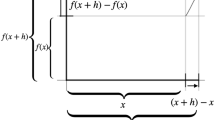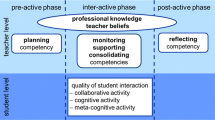Abstract
An important role of theory in research is to provide new ways of conceptualizing practical questions, essentially by transforming them into scientific problems that can be more easily delimited, typified and approached. In mathematics education, theoretical developments around ‘metacognition’ initially appeared in the research domain of Problem Solving closely related to the practical question of how to learn (and teach) to solve non-routine problems. This paper presents a networking method to approach a notion as ‘metacognition’ within a different theoretical perspective, as the one provided by the Anthropological Theory of the Didactic. Instead of trying to directly ‘translate’ this notion from one perspective to another, the strategy used consists in going back to the practical question that is at the origin of ‘metacognition’ and show how the new perspective relates this initial question to a very different kind of phenomena. The analysis is supported by an empirical study focused on a teaching proposal in grade 10 concerning the problem of comparing mobile phone tariffs.
Similar content being viewed by others
Notes
In mathematics, a well-known example of distance between a system and the model used to solve problems appearing in this system is Galois’ theory (using groups and fields) and the problem of solving polynomial equations by radicals. In classical mechanics, the modelling of the solar system, where planets appear as points provided with mass, represents another paradigmatic example of a model that is very distant from the modelled system. It has, however, been extremely efficient to formulate scientific problems related to the solar system and to increase our knowledge about it.
See also Silver & Herbst (2007, p. 62).
Schoenfeld (2007) provides good overview of research results about Problem Solving in the USA during the period 1970 to present.
This is an idea developed by Brousseau in 1986. See Brousseau (1997, pp. 37–40).
This is the formulation used by the OECD in the PISA programme: ‘The assessment is forward-looking, focusing on young people’s ability to use their knowledge and skills to meet real-like challenges, rather than just examining the extent to which they have mastered a specific school curriculum.’
With this assumption, the ATD joins some other visions of human knowledge as the one proposed by the British anthropologist Mary Douglas in her book ‘How institutions think’ (Douglas, 1987).
For more details, see Barbé et al. (2005).
The idea of didactic moment is defined not in a chronological or linear sense, but in the sense of different dimensions (o factors) of the mathematical activity.
For more details on didactic praxeologies and their structuring in didactic moments, see Barbé et al. (2005).
An example of such institutional restrictions in the case of the teaching of limits of functions can be found in Barbé et al. (2005).
From this point of view, the new formulation of Pólya’s problem takes into account the minimal unity of analysis of didactic processes postulated by the ATD: “To describe and interpret didactic phenomena, they have to be related to a sequence of the didactic process including, at least, the process of constructing a local mathematical praxeology” (Bosch & Gascón 2005).
More details about this experimentation are given in Rodríguez (2005).
This proposal is coherent with the evolution of the ‘didactic contract’ as described by Brousseau: “The didactic contract involves the project of its own dissolution. It is understood from the beginning of the didactical relationship that a moment must arrive when it will be broken. At that moment, at the end of the teaching, the taught system will, with the help of the learned knowledge, be assumed to be capable of facing systems without didactical intentions.” (Brousseau, 1997, p. 57).
References
Adibnia, A., & Putt, I. J. (1998). Teaching problem solving to year 6 students: a new approach. Mathematics Education Research Journal, 10(3), 42–58.
Barbé, J., Bosch, M., Espinoza, L., & Gascón, J. (2005). Didactic restrictions on the teacher’s practice: the case of limits of functions in Spanish high schools. Educational Studies in Mathematics, 59, 235–268.
Barquero, B., Bosch, M., & Gascón, J. (2008). Using research and study courses for teaching mathematical modelling at university level. In D. Pitta-Pantazi, & G. Pilippou (Eds.), Proceedings of the fifth congress of the European society for research in mathematics education (pp. 2050–2059). Cyprus: University of Cyprus.
Bosch, M., & Gascón, J. (2005). La praxéologie comme unité d’analyse des processus didatiques. In A. Mercier, & C. Margolinas (Coord.), Balises en Didactique des Mathématiques (pp. 107–122). Grenoble: La Pensée Sauvage.
Brousseau, G. (1997). Theory of didactical situations in mathematics. Didactique des Mathématiques 1970–1990. Dordrecht: Kluwer.
Chevallard, Y. (1999). L’analyse de pratiques professorales dans la théorie anthropologique du didactique. Recherches en Didactique des Mathématiques, 19(2), 221–266.
Chevallard, Y. (2004), Vers une didactique de la codisciplinarité. Notes sur une nouvelle épistémologie scolaire. Journées de didactique comparée. Lyon (3–4 mai 2004). http://yves.chevallard.free.fr/spip/spip/article.php3?id_article=45.
Chevallard, Y. (2006). Steps towards a new epistemology in mathematics education. In M. Bosch (Ed.) Proceedings of the IV Congress of the European Society for Research in Mathematics Education (CERME 4) (pp. 1254–1263). Barcelona: FUNDEMI IQS.
Chevallard, Y. (2008). Readjusting didactics to a changing epistemology. Invited panel session at the European conference on education research, Genève, 13–15 September 2006 (in press).
Chevallard, Y., Bosch, M., & Gascón, J. (1997). Estudiar matemáticas. El eslabón perdido entre la enseñanza y el aprendizaje. Barcelona: ICE/Horsori.
Clarke, D. J., Stephens, W. M., & Waywood, A. (1992). Communication and the learning of mathematics. In T. A. Romberg (Ed.), Mathematics assessment and evaluation: imperatives for mathematics educators. (pp. 184–212). New York: The State University of New York Press.
Douglas, M. (1987). How institutions think. London: Routledge & L. Kegan Paul.
Fan, L., & Zhu, Y. (2007). From convergence to divergence: the development of mathematical problem solving in research, curriculum, and classroom practice in Singapore. ZDM—The International Journal on Mathematics Education, 39(5–6), 491–501.
Flavell, J.H. (1976), Metacognitive aspects of problem solving. In L.B. Resnick (Ed.). The nature of intelligence (pp. 231–236). Hillsdale: Erlbaum.
García, F. J., Gascón, J., Ruiz Higueras, L., & Bosch, M. (2006). Mathematical modelling as a tool for the connection of school mathematics. ZDM—The International Journal on Mathematics Education, 38(3), 226–246.
Garofalo, J., & Lester, F. K. (1985). Metacognition, cognitive monitoring, and mathematical performance. Journal for Research in Mathematics Education, 16(3), 163–176.
Gascón, J. (2003). From the cognitive to the epistemological programme in the didactics of mathematics: two incommensurable scientific research programmes? For the Learning of Mathematics, 23(2), 44–55.
Goos, M. (1995). Metacognitive decision-making and social interactions during paired problem solving. Mathematics Education Research Journal, 6(2), 144–165.
Kaune, C. (2006). Reflection and metacognition in mathematics education—tools for the improvement of teaching quality. ZDM—The International Journal on Mathematics Education, 38(4), 350–360.
Kilpatrick, J. (1985). A retrospective account of the past twenty-five years of research on teaching mathematical problem solving. In E. Silver (Ed.), Teaching and learning mathematical problem solving: multiple research perspectives (pp. 1–15). Hillsdale: Erlbaum.
Kuhn, T. S. (1962). The structure of scientific revolutions. Chicago: University of Chicago Press.
Lester, F.K., & Garofalo, J. (1982). Mathematical problem solving: issues in research. Philadelphia: Franklin Institute Press.
Lester, F. (1994). Musings about mathematical problem-solving research: The first 25 years in JRME. Journal for Research in Mathematics Education, 25(6), 660–675.
McAfee, O., & Leong, D. J. (1994). Assessing and guiding young children’s development and learning. Boston: Allyn & Bacon.
Niss, M. (1999). Aspects of the nature and state of research in mathematics education. Educational Studies in Mathematics, 40, 1–24.
Pólya, G. (1981). Mathematical discovery. On understanding, learning, and teaching problem solving. New York: Wiley (Combined paperback edition).
Rodríguez, E. (2005). Metacognición, matemáticas y resolución de problemas: una propuesta integradora desde el enfoque antropológico. Doctoral dissertation. Universidad Complutense de Madrid, Madrid.
Rodríguez, E., Bosch, M., & Gascón, J. (2008). An anthropological approach to ‘Metacognition’: the research and study courses. In D. Pitta-Pantazi, & G. Pilippou (Eds.), Proceedings of the fifth congress of the European society for research in mathematics education (pp. 1798–1807). Cyprus: University of Cyprus.
Ruiz, N., Bosch, M., & Gascón, J. (2008). The functional algebraic modelling at secondary level. In D. Pitta-Pantazi, & G. Pilippou (Eds.), Proceedings of the fifth congress of the European society for research in mathematics education (pp. 2170–2179) Cyprus: University of Cyprus.
Schoenfeld, A. H. (1985a). Mathematical problem solving. San Diego: Academic Press.
Schoenfeld, A. H. (1985b). Metacognitive and epistemological issues in mathematical understanding. In E. Silver (Ed.), Teaching and learning mathematical problem-solving: multiple research perspectives (pp. 361–380). Hillsdale: Erlbaum.
Schoenfeld, A. H. (1985c). Making sense of “out loud” problem-solving protocols. Journal of Mathematical Behaviour, 4, 171–191.
Schoenfeld, A. H. (1987). Cognitive science and mathematics education. Hillsdale: Erlbaum.
Schoenfeld, A. H. (1992). Learning to think mathematically: problem solving, metacognition, and sense-making in mathematics. In D. Grouws (Ed.), Handbook for research on mathematics teaching and learning (pp. 334–370). New York: MacMillan.
Schoenfeld, A. H. (2007). Problem solving in the United States, 1970–2008: research and theory, practice and politics. ZDM—The International Journal on Mathematics Education, 39(5–6), 537–551.
Silver, E. (1985). The teaching and assessing of mathematical problem solving. Reston: National Council of Teachers of Mathematics (NCTM).
Silver, E., & Herbst, P. (2007). Theory in mathematics education scholarship. In F. K. Lester (Ed.), Second handbook of research on mathematics teaching and learning (pp. 39–67). Charlotte: Information Age Publishing.
Silver, E., & Marshall, S. (1990). Mathematical and scientific problem solving: findings, issues, and instructional implications. In B. F. Jones & L. Idol (Eds.), Dimensions of thinking and cognitive instruction (pp. 265–290). Hillsdale: Erlbaum.
Wilson, J., & Clarke, D. (2004). Towards the modelling of mathematical metacognition. Mathematics Education Research Journal, 16(2), 25–48.
Author information
Authors and Affiliations
Corresponding author
Rights and permissions
About this article
Cite this article
Rodríguez, E., Bosch, M. & Gascón, J. A networking method to compare theories: metacognition in problem solving reformulated within the Anthropological Theory of the Didactic. ZDM Mathematics Education 40, 287–301 (2008). https://doi.org/10.1007/s11858-008-0094-z
Accepted:
Published:
Issue Date:
DOI: https://doi.org/10.1007/s11858-008-0094-z




